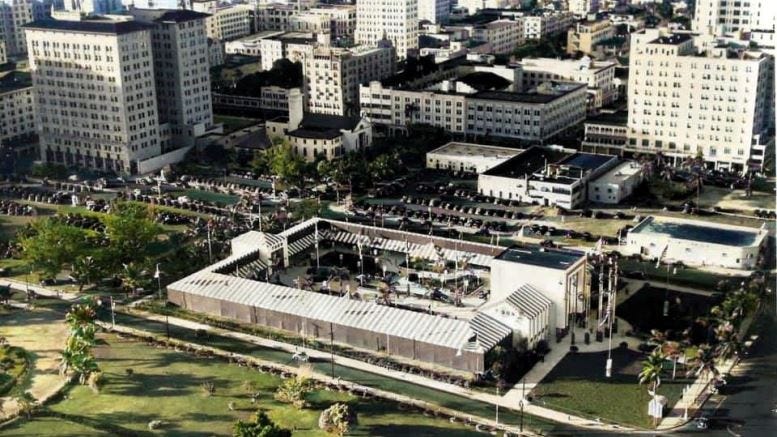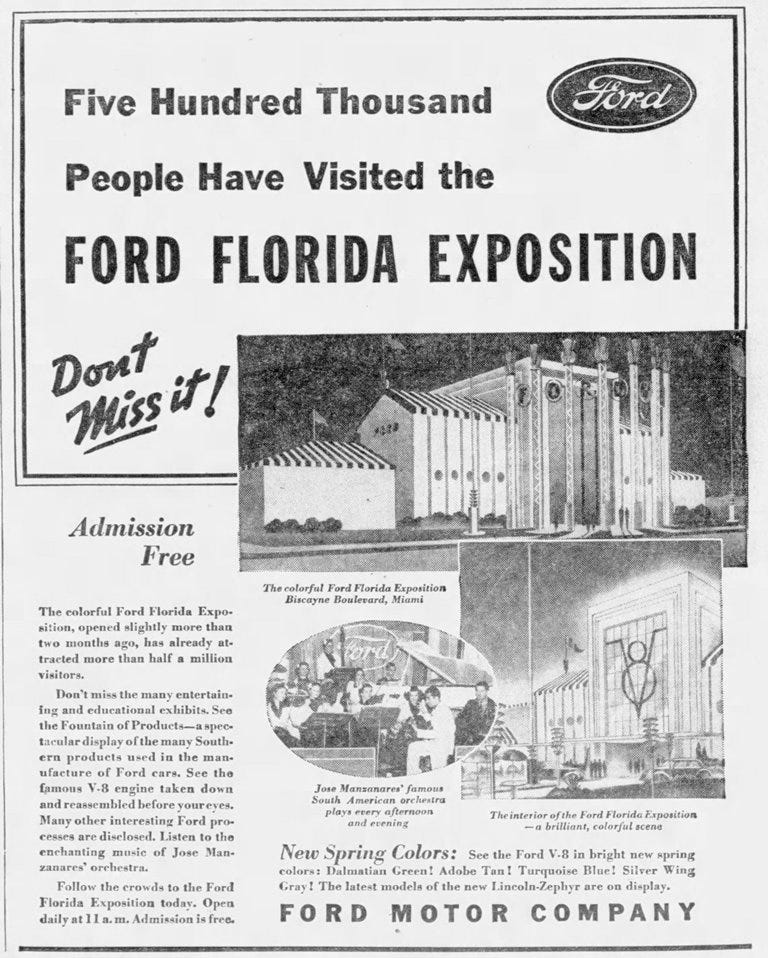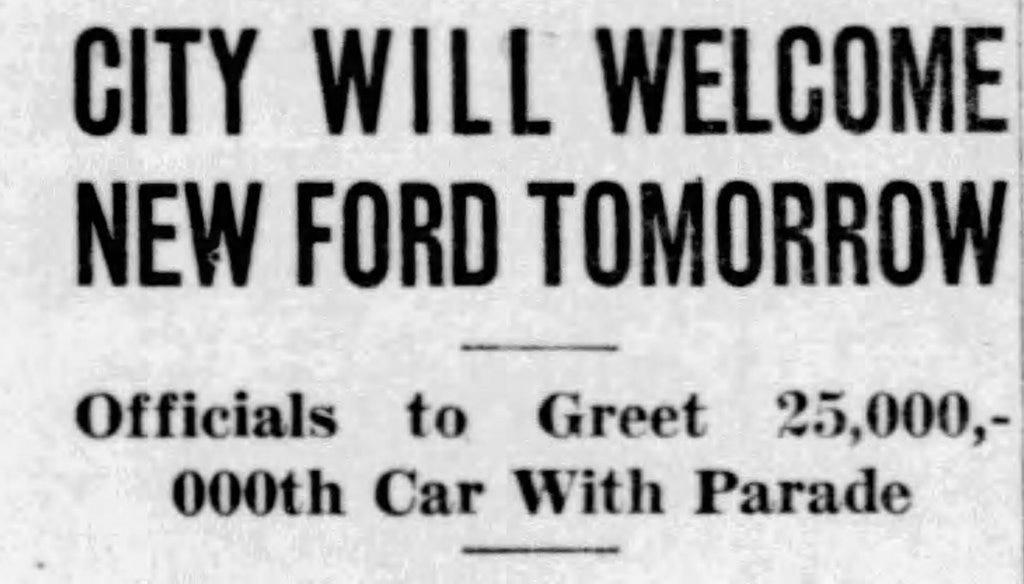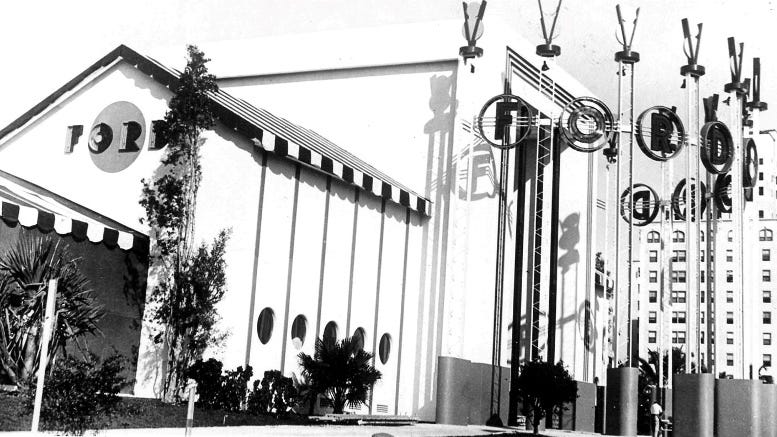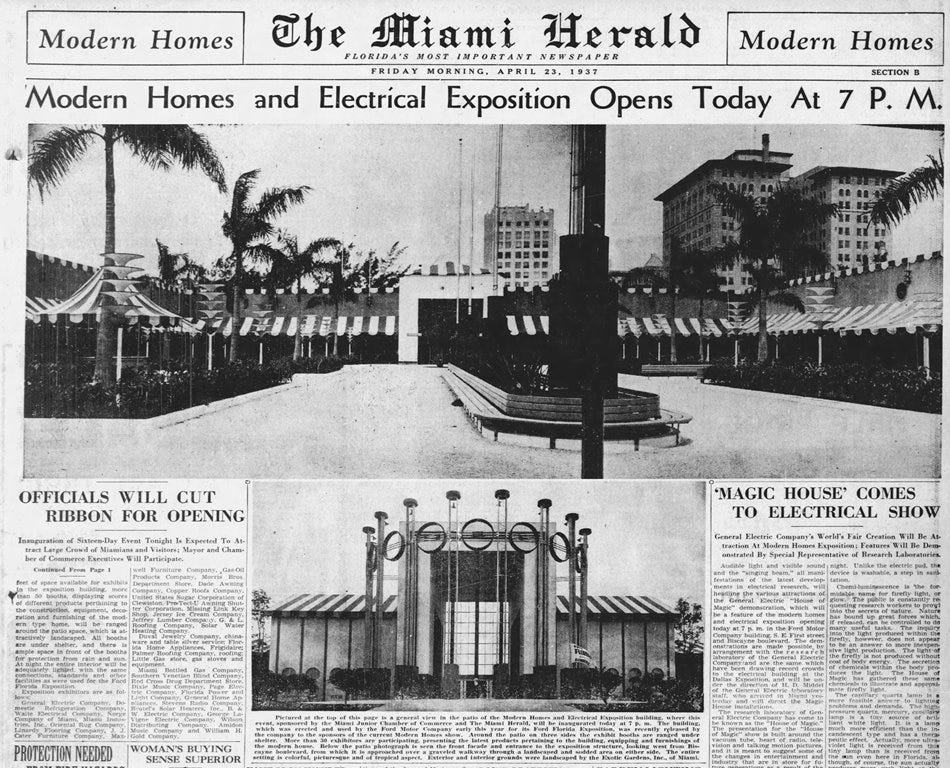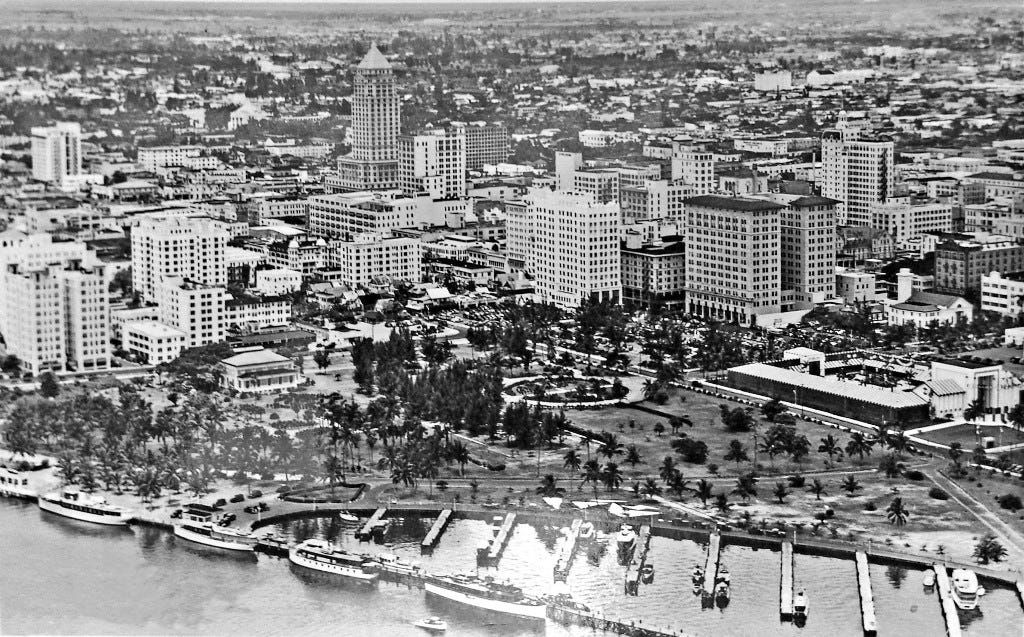Exposition Building in Downtown Miami (1937)
The story of the temporary exhibition building, constructed on the former site of Royal Palm Park, for the Ford Exposition convention in 1937
After ten years of economic malaise during the Great Depression, South Florida began to show signs of economic recovery by 1936. Miami Beach saw a construction boom of apartment buildings and hotels which provided accommodations for the working class who were granted and took advantage of paid vacation for the first time during this era. The boom provided a vacation destination for Americans who were ready to start traveling after years of sacrifice during the depths of economic stagnation.
Across the causeway from the beach, downtown Miami also benefited from South Florida’s slow emergence out of the Depression when Ford Motor Company announced the Ford Florida Exposition of 1937. The automobile manufacturer began work on what would become a temporary convention center in the Fall of 1936 for a showcase of their new line of automobiles and trucks. The exposition would ultimately attract a quarter of a million visitors to the Magic City signaling that an economic recovery was on the horizon. This is the story of the convention and the building that hosted the event, which became the centerpiece of downtown Miami for one year in 1937.
Formerly Part of Royal Palm Park
The Ford Exposition structure was erected on what was once part of Royal Palm Park. The parcel of land that hosted the building was one of Miami’s earliest sports venues which featured a baseball diamond and a makeshift football stadium providing a gridiron field for Miami High School in the early 1900s.
To the north of the field was a gazebo that was used as a pulpit by William Jennings Bryan when he conducted Sunday service from the park in the 1910s and early 1920s. He started providing bible study in the First Presbyterian Church, which stood on the northern end of the park, but it ended up not being big enough to accommodate the large masses of people who gathered to see and hear him preach. The crowds were so large that the entire park was taken over by worshippers during one of Bryan’s Sunday sermons.
After the construction of Bayfront Park in 1924, and the closing of the Royal Palm Hotel in 1928, Royal Palm Park, which was owned by the Model Land Company, sat vacant at the onset of the 1930s. When the Ford Motor Company came to Miami to find a location for their exposition center, they naturally selected the open parcel of land between SE First Street and SE Second Street, bounded by Biscayne Boulevard on the east, and SE Third Avenue on the west, that was once part of Royal Palm Park.
Expo Building Constructed in 1936
On November 29, 1936, the Miami Herald published an article announcing Ford Motor Company’s intention to build an exhibit pavilion for $75,000 on the parcel of land that was once part of Royal Palm Park. The article emphasized the importance of Ford’s decision to select Miami for this historic exhibit. The event was expected to attract hundreds of thousands of visitors from around the world in 1937.
The Ford exhibit pavilion was described as follows:
“The Miami project will be among the most elaborate of Ford exhibits presented to date. The structure proper, which will have dimensions of 200 by 340 feet, will be a colorful showplace. The center entrance pavilion will be 40 feet wide and 115 feet long, containing offices of the building and public rooms. In all, there will be four steel and stucco pavilions, one on the center line of each side of the lot, connected by brilliant awnings supported on steel frames. Sidewalls will be in cobalt blue and the roof striped in vermillion and white.”
The front entrance featured a series of steel lattice columns, 50 feet high, surmounted by five-foot yellow and vermillion replicas of Ford V-8s. In between the pillars were brilliant electric lights that highlighted the letters F-O-R-D. There were floodlights at the base of the columns illuminating the entire front of the building.
Down the center of the main pavilion was a reflecting pool which was 85 feet long, lined with glass brick and illuminated by iridescent lights, it was surrounded by colored umbrellas and tables along the patio. The main pavilion was where a visitor could enjoy the sounds of Jose Manzanares’ South American orchestra, which was the live music entertainment during the three-month exposition.
Formal Opening of Ford Exposition
By opening evening on Friday, January 15, 1937, the Ford Motor Company stated that they had invested $75,000 to construct the expo building and estimated that the operating cost of the event will require an additional $250,000. The Ford Florida Exposition was considered the largest industrial exhibit ever conducted by a manufacturer in the state of Florida at that time.
The commencement event began at 9:00pm and lasted until midnight. The excitement for the grand opening of the exposition attracted more than ten thousand people for the three-hour event. The opening festivities featured a luncheon of dealers and factory representatives during the day, and a banquet of chamber of commerce officials, state, and city leaders at the Columbus Hotel in the early evening.
Illuminated and decorated in holiday colors, the facility stood out on the city block that it occupied on Biscayne Boulevard. The main entrance featured a landscape of tropical vegetation accented with mature royal palm trees. The broad patio at the entrance was as grand as the opening night’s events. On the opposite side of the patio was a parade of the latest models of Lincoln, Lincoln Zephyr, and Ford V-8 automobiles and trucks.
Overall, the opening of the fair was considered a great success. An article in the Miami Herald declared:
“Visitors adjudged the exposition to be one of the most beautiful buildings in Metropolitan Miami and pointed out that the towering structure in Biscayne Boulevard will be a feature in the vacation plans of thousands now flocking to the Miami area.”
While the Ford Motor Company celebrated the unveiling of their exposition, the Knights Templar officials were planning their 40th triennial conclave, which would also take place in Miami in July of 1937. The magnificence of the exposition pavilion was not lost on those officials as they searched for a suitable venue for their event. The Knights Templar organizers expected more than 40,000 attendees during their late summer event.
Attendance During Exposition
The first week of the Ford Florida Exposition was just as successful as opening night. W.C. Cowling, general sales manager of Ford, announced that 56,500 people had visited the exposition in the first three days after the grand opening. He stated that the most popular exhibits in the main pavilion were the “Fountain of Southern Products”, which stood near the broad entrance, the rapid engine assembly, the balances display, the mirrored roll over chassis, and demonstrations of the new Ford V-8s and Lincoln automobiles.
The traffic through the exposition continued at a high volume through the first month. The event attracted over 200,000 visitors in the first 23 days, and reached the 250,000-visitor milestone by February 20, 1937, five days prior to the one-month mark from the grand opening date. Local school children were given free entrance and encouraged to attend the educational seminars.
Appeal of the Ford Florida Exposition continued into March when the show officially reached the 500,000-visitor mark on March 14th. Overall, the interest and total attendance of the exposition exceeded the expectations of the organizers and city leadership by the end of the event in mid-April.
Ford’s Milestone Automobile
The Ford Expo show coincided with a significant milestone for the car manufacture. Officials for the organization announced that the 25 millionth vehicle will roll off the assembly line at the Ford River Rouge plant in Michigan during the exposition. As part of the event, and to celebrate the achievement, Ford worked with local officials to ceremoniously welcome this vehicle during the exposition.
The car was shipped down to the Miami city limits on February 27, 1937, and would be paraded to the Ford Florida Exposition building. The welcoming committee escorted the vehicle from the city limits to the expo building and were accompanied by the Junior Chamber 100-piece marching band as part of procession. Once the vehicle arrived, a special broadcast conducted by Norman McKay of WQAM signaling the completion of the car’s journey. After this special ceremony, the car remained on exhibit for the remainder of the show, which concluded on April 11, 1937.
During the course of the exposition, the post office installed a temporary mail station in the expo building to handle the large number of postcards that were mailed during the nearly three-month show. Postcards were given to visitors for free, providing an opportunity for those who traveled to the event to make their friends from their home town envious. The variety of postcards created for the event provided a nice collection of pictures and correspondence detailing how tourists and locals experienced the show.
City Buys the Expo Building
As it became apparent that the Knights Templar preferred to utilize the exposition building for their triennial event in July of 1937, the city decided to approach Ford Motor Company about buying the facility after the Ford Florida Expo concluded. Per their agreement with the Model Land Company, the entity that owned the land, Ford was required to remove the temporary structure by June 1, 1937. Given this arrangement, city officials also needed to negotiate an extended lease with the Model Land Company in order to provide the venue for the Knights.
Miami’s city manager, L.L. Lee, negotiated a transfer and extension of the land lease Ford had with the Model Land Company, and then agreed to purchase the building for $5000 with the understanding that the city would be responsible for demolition and removal of the structure at the conclusion of the 60-day extension. Cost of removal of the building was estimated at $3000, which was considered less than half the value of the salvage of the materials, which city officials used as justification to take on the responsibility of removing the facility at the conclusion of the Knights Templar conclave.
The offer to sell the building to the city was accepted by Ford Motor Company on April 30th. The building, constructed primarily of steel and canvas, was put together in such a way that it would be easy to disassemble, allowing for the materials to be repurposed in various other city projects or sold on the open market. On May 6, the Model Land Company agreed to an assignment and a two-month extension of the land lease for $1000, while, on the same day, the Knights Templar wrote a check for $1000 to the city for two-months rental of the facility for their convention in July. The city reported that they estimate the value of the salvage of the building to be roughly $15,000. However, that would later prove to be a very generous estimate by city officials.
Renovation and Fate of Ford Expo Building
Less than two weeks after the conclusion of the Ford Florida Exposition, the expo building hosted the Modern Homes & Electrical Expo. The home show began on April 23rd and ran for sixteen days featuring lectures and educational exhibits on trends in home living. Admission for the show was free and it attracted thousands of attendees up until the last night on May 8th, 1937, when the visitor count exceeded seven thousand people.
On May 21st, the Knights Templar Conclave Committee moved their offices from the second floor of the old post office (the former federal building and post office at the corner of NE First Avenue and NE First Street), to the exposition building. In an article in the Miami Herald announcing the move, John B. Phelps, chairman of the committee, offered an estimate that there would be 50,000 visitors from all parts of the United States and Canada who would attend the festivities in Miami.
By the end of May, the Templar City, a name given to the former Ford Florida exposition center as it was being remodeled for the Knights Templar convention, was rapidly taking shape. A Miami Herald article on May 29th described the transformation of the one-block convention center as follows: “Templar City, Biscayne Boulevard and SE First Street, will be a colorful, brilliant building with glowing neon lights, bunting, flags, and Knights Templar insignias displayed in abundance.”
While the exposition structure was being renovated for the conclave, the Miami city commission was entertaining an offer of $5000 from Harrison McCready to purchase the Ford Exposition structure with a plan to make it a permanent convention center. The idea was to attract national and international manufacturers to host conventions in a concept described by the visionary as a Pan-American Mart.
McCready’s proposal indicated that he would sign a five-year lease with the Model Land Company for the land and would replace the temporary canvas sides and top with permanent materials, to reinforce the structure for a more permanent standing. Ultimately, the commission determined that the salvage material from the structure was worth more than what McCready offered, and the plan never got any serious consideration.
After declining McCready’s offer, the city commission discussed purchasing some of the salvaged stones from the Halcyon Hall Hotel on Flagler Street as materials to construct a public library within the city limits. The Halcyon Hall Hotel was being razed in 1937 to make room for the Alfred I Dupont building which still sits on the corner of NE Second Avenue and Flagler Street today. The funds for this purchase were tied to the sale of reclaimed materials from the exposition building after the Knights Templar conclave concluded.
Although this was discussed in May of 1937, a public library in Bayfront Park was not constructed by the city until 1951. It is unclear if any of the Halcyon Hall Hotel stones were used in the construction of the library building, but the discussion in 1937 indicated that local officials had begun thinking about a municipal library, funded by either the city or county, years before it was officially built.
Knights Templar Conclave
The Knights Templar, one of the oldest fraternal organizations, kicked off their fortieth triennial conclave in Miami on Saturday, July 17, 1937. Registration and kickoff meetings began at the McAllister Hotel, but the focal point of the conference was at the revamped Ford exposition site, rebranded as ‘Templar City’.
The weekend saw more than 50,000 visitors arrive by train, via the Seaboard Air Line railway station, automobile, plane, and steamship. The official opening of the meeting took place on Tuesday, July 20th, at the Royal Palm Club which stood at the southeastern point of Bayfront Park. However, the bulk of the visitors congregated at Templar City for the core of activities associated with the conclave.
At the time of the opening, the Miami Herald described the revamped exposition building:
“Lights emblazon the name ‘Templar City’ while the Cross of Salem, insignia of the grand master, is centered over the entrance. The building was constructed originally to house the Florida Ford Exposition and has been decorated with the Knights Templar banners and insignia. In the entrance on the side walls are 22-foot-high portraits of Andrew Davison Agnew, grand master, and Mark Norris, deputy grand master. Inside is an open-air landscaped court decked over with hundreds of emblems of the order while around the court are wide stalls with the name of each state above the entrance.”
The meetings concluded on Friday, July 23rd, with the election of Mark Norris as the next grand master, as well as elections of other official national posts within the organization. However, the Grand Encampment officers were unable to decide on the host city for the next triennial conclave in 1940. The three options were Cleveland, Saint Louis, and Saint Paul, but none of the finalists had an endorsement by their state commandries, so a decision could not be reached. Their Knights Templar constitution was amended to allow the selection to take place after the conclave concluded.
End of the Exposition Building
Once the Knights Templar meeting concluded, the city commission had until the end of August to clear the land the exposition center resided per their agreement with the Model Land Company. The city manager, A.D.F. Blood, placed an advertisement on August 10th to find a demolition and salvage company who would offer a fair price for the building materials and take responsibility for the demolition. However, they did not receive an acceptable proposal.
By August 14th, the city commission authorized the dismantling of the exposition structure, leaving them to determine the fate of the building materials salvaged from the demolition. After disassembly of the convention hall, the reclaimed materials were stored in a hangar at the Opa Locka airport until the city either found a suitable use or received an acceptable bid for the materials.
Once the land was cleared from the downtown city block bound by Biscayne Boulevard, SE Third Avenue, and SE First and Second Streets, it sat vacant until it was purchased in 1941 by the Royal Palm Group headed by Edward Claughton. He erected a strip mall with seven stores along with the Royal Theater, operated by the Claughton theater management company.
By 1955, First National Bank purchased an option to buy the land from Claughton and eventually erected their corporate offices on the property in 1958. Today the building formerly occupied by First National Bank, and later Vitas Healthcare, is now vacant and is slated for demolition in the near future. The property will be redeveloped by the Florida East Coast Realty organization, headed by Tibor Hollo, into a supertall tower called One Bayfront Plaza, which will reach a height of 1,049 feet. As of the publish date of this article, timing of the onset of the project had not been announced.
While the Ford Florida Exposition building was only around for one year, it represented hope during one of the most devastating economic periods in this country’s history. In particular, it provided optimism for a community that had experienced dark economic times several years earlier than the rest of the country following the great real estate bust in 1926. For the Magic City, the exposition in 1937 was more than just another milestone tourist event in the city’s history, it was a sign that the municipality was moving in a positive economic direction following some very bleak years during the depths of the Great Depression.
Resources:
Miami News: “Ford to Build Miami Exhibit”, November 29, 1936.
Miami Tribune: “Ford Exhibit Opens Friday”, January 13, 1937.
Miami Herald: “Exposition Tribute to Area as Market”, January 16, 1937.
Miami News: “56,500 See Ford Miami Exposition”, January 19, 1937.
Miami Herald: “More Than 200,000 See the Ford Show”, February 7, 1937.
Miami Herald: “Miamians To Greet 25,000,000th Ford”, February 19, 1937.
Miami Herald: “Ford Exposition Visited by 250,000”, February 20, 1937.
Miami Herald: “Nearly 500,000 See Ford Miami Show”, March 14, 1937.
Miami Herald: “Speed Arrangements for Templar Crowd”, April 9, 1937.
Miami Herald: “City to Lease Ford Building”, April 13, 1937.
Miami Tribune: “Templars Seek Ford Structure”, April 13, 1937.
Miami Herald: “Details Discussed for Miami Conclave”, April 23, 1937.
Miami Herald: “Modern Homes and Electrical Opens Today at 7pm”, April 23, 1937.
Miami Herald: “Exposition Building Offer is Accepted”, April 30, 1937.
Miami Herald: “Knights Templar Quarters Moving”, May 21, 1937.
Miami Herald: “Templar Convention Setting is Colorful”, May 29, 1937.
Miami News: “City May Purchase Stone for Library”, June 4, 1937.
Miami Herald: “Committee to Study Bid for Ford Building”, June 25, 1937.
Miami Tribune: “City Plans Sales of Exposition Site”, August 10, 1937.
Miami News: “Ford Building Bids Are Sought”, August 10, 1937.
Miami Herald: “Razing of Exposition Building is Ordered”, August 14, 1937.
Miami Herald: “Royal Palm Group Buys Miami Land”, December 21, 1941.
Miami Herald: “Miami Bank Plans New Building”, January 2, 1955.
Miami Herald: “New Bank Going Up in Spring”, February 16, 1956.
Miami News: “Royal Theater Sale is Seen”, January 31, 1957.
Miami News: “Royal Movie to Make Way for Building”, February 2, 1957.
Images:
Cover: Aerial of Expo Building in 1937 (colorized). Courtesy of Larry Wiggins.
Figure 1: William Jennings Bryan in Royal Palm Park in 1921. Courtesy of Florida State Archives.
Figure 2: Ford Florida Exposition on February 15, 1937. Courtesy of Miami-Dade Public Library, Romer Collection.
Figure 3: Ford Expo Pavilion Postcard. Courtesy of Author.
Figure 4: Ad for Ford Florida Exposition on April 7, 1937. Courtesy of Miami Tribune.
Figure 5: Headline in Miami News on February 26, 1937. Courtesy of Miami News.
Figure 6: Ford Expo Building Entrance. Courtesy of Author.
Figure 7: Front Page of Miami Herald on April 23, 1937. Courtesy of Miami Herald.
Figure 8: Entrance to Templar City on July 26, 1937. Courtesy of Author.
Figure 9: Templar Knights at Triennial Conclave in 1937. Courtesy of Author.
Figure 10: Ford Expo in Royal Palm Park in 1937. Courtesy of Larry Wiggins.





